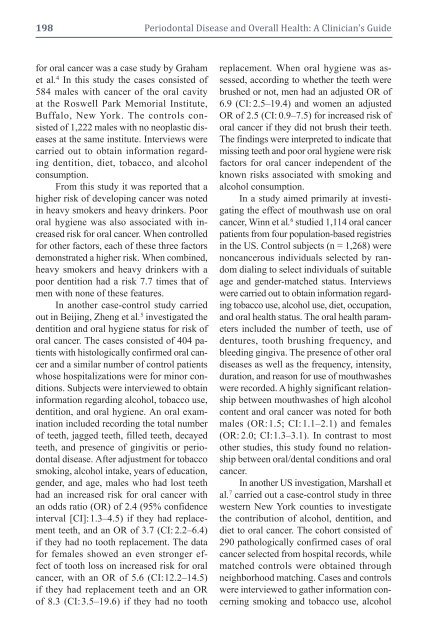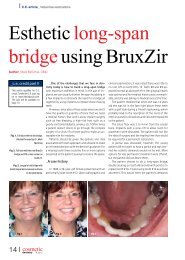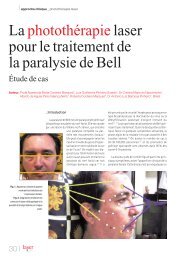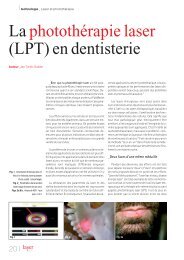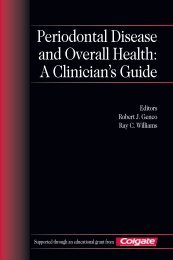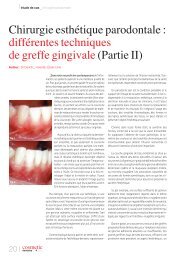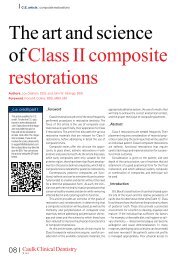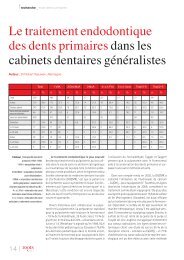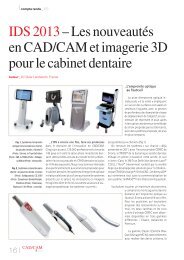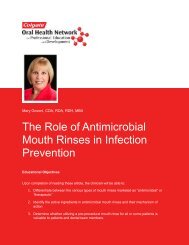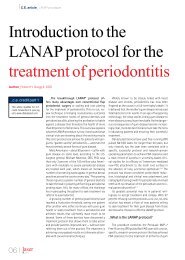Periodontal Disease and Overall Health: A Clinician's Guide
Periodontal Disease and Overall Health: A Clinician's Guide
Periodontal Disease and Overall Health: A Clinician's Guide
You also want an ePaper? Increase the reach of your titles
YUMPU automatically turns print PDFs into web optimized ePapers that Google loves.
198 <strong>Periodontal</strong> <strong>Disease</strong> <strong>and</strong> <strong>Overall</strong> <strong>Health</strong>: A <strong>Clinician's</strong> <strong>Guide</strong>for oral cancer was a case study by Grahamet al. 4 In this study the cases consisted of584 males with cancer of the oral cavityat the Roswell Park Memorial Institute,Buffalo, New York. The controls consistedof 1,222 males with no neoplastic diseasesat the same institute. Interviews werecarried out to obtain information regardingdentition, diet, tobacco, <strong>and</strong> alcoholconsumption.From this study it was reported that ahigher risk of developing cancer was notedin heavy smokers <strong>and</strong> heavy drinkers. Poororal hygiene was also associated with increasedrisk for oral cancer. When controlledfor other factors, each of these three factorsdemonstrated a higher risk. When combined,heavy smokers <strong>and</strong> heavy drinkers with apoor dentition had a risk 7.7 times that ofmen with none of these features.In another case-control study carriedout in Beijing, Zheng et al. 5 investigated thedentition <strong>and</strong> oral hygiene status for risk oforal cancer. The cases consisted of 404 patientswith histologically confirmed oral cancer<strong>and</strong> a similar number of control patientswhose hospitalizations were for minor conditions.Subjects were interviewed to obtaininformation regarding alcohol, tobacco use,dentition, <strong>and</strong> oral hygiene. An oral exam -ination included recording the total numberof teeth, jagged teeth, filled teeth, decayedteeth, <strong>and</strong> presence of gingivitis or perio -dontal disease. After adjustment for tobaccosmoking, alcohol intake, years of education,gender, <strong>and</strong> age, males who had lost teethhad an increased risk for oral cancer withan odds ratio (OR) of 2.4 (95% confidenceinterval [CI]:1.3–4.5) if they had replacementteeth, <strong>and</strong> an OR of 3.7 (CI: 2.2–6.4)if they had no tooth replacement. The datafor females showed an even stronger effectof tooth loss on increased risk for oralcancer, with an OR of 5.6 (CI:12.2–14.5)if they had replacement teeth <strong>and</strong> an ORof 8.3 (CI:3.5–19.6) if they had no toothreplacement. When oral hygiene was assessed,according to whether the teeth werebrushed or not, men had an adjusted OR of6.9 (CI: 2.5 –19.4) <strong>and</strong> women an adjustedOR of 2.5 (CI: 0.9–7.5) for increased risk oforal cancer if they did not brush their teeth.The findings were inter preted to indicate thatmissing teeth <strong>and</strong> poor oral hygiene were riskfactors for oral cancer independent of theknown risks associated with smoking <strong>and</strong>alcohol consumption.In a study aimed primarily at investigatingthe effect of mouthwash use on oralcancer, Winn et al. 6 studied 1,114 oral cancerpatients from four population-based registriesin the US. Control subjects (n = 1,268) werenoncancerous individuals selected by r<strong>and</strong>omdialing to select individuals of suitableage <strong>and</strong> gender-matched status. Interviewswere carried out to obtain information regard -ing tobacco use, alcohol use, diet, occupation,<strong>and</strong> oral health status. The oral health param -eters included the number of teeth, use ofdentures, tooth brushing frequency, <strong>and</strong>bleeding gingiva. The presence of other oraldiseases as well as the frequency, intensity,duration, <strong>and</strong> reason for use of mouthwasheswere recorded. A highly significant relationshipbetween mouthwashes of high alcoholcontent <strong>and</strong> oral cancer was noted for bothmales (OR:1.5; CI:1.1–2.1) <strong>and</strong> females(OR: 2.0; CI:1.3–3.1). In contrast to mostother studies, this study found no relationshipbetween oral/dental conditions <strong>and</strong> oralcancer.In another US investigation, Marshall etal. 7 carried out a case-control study in threewestern New York counties to investigatethe contribution of alcohol, dentition, <strong>and</strong>diet to oral cancer. The cohort consisted of290 pathologically confirmed cases of oralcancer selected from hospital records, whilematched controls were obtained throughneighborhood matching. Cases <strong>and</strong> controlswere interviewed to gather information concerningsmoking <strong>and</strong> tobacco use, alcohol


